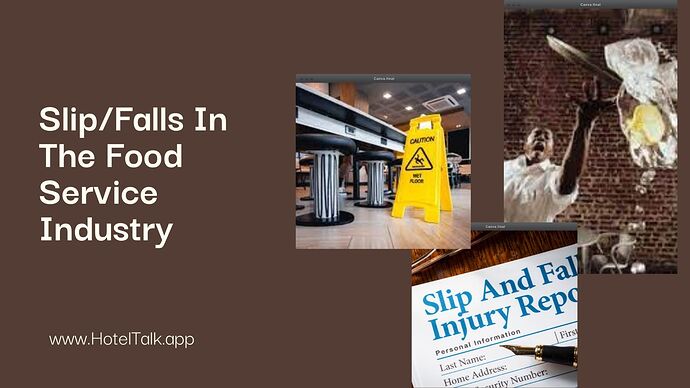Introduction: Slip/falls are a common occurrence in the food service industry.
Falls are the leading cause of injury in the industry, and it is estimated that up to one-half of all food service employees will have a fall during their careers. The majority of slip/fall injuries occur on slippery floors due to spills or condensation or from falling objects or equipment.
Causes:
Common causes of slip/falls include wet or icy surfaces, spills, and poor lighting. Symptoms:
Other causes include wet floors, spills, and poor lighting. Workers are often injured when they fall from a ladder or other elevated surface. When you hurry or rush, wear the improper shoes, or don’t pay attention to where you’re walking, you’re more likely to slip.
Prevention:
There are several steps that can be taken to help prevent slip/falls in the food service industry. First, ensure that the floors are dry and free of debris. Second, walkways should be properly lit to help prevent slips and falls. Third, employees should avoid wearing high heels or shoes with slippery soles. Also make sure employees have slip-resistant footwear at all times.
In addition to the steps listed above, employers can also implement fall prevention programs that address slip and fall hazards. The following are some of the most common measures that employers should consider implementing.
1 Provide and maintain slip-resistant mats at all entrances, exits and other areas where employees walk.
2 Install handrails on stairways that are frequently used by employees.
3 Use warning signs or barricades to mark slippery areas.
4 Install and maintain light fixtures that can be turned off at night.
5 Provide linoleum flooring in bathrooms, hallways and similar areas.
Treatment:
First aid for minor injuries, seeking medical attention for more serious injuries. Use: The following are some common slip and fall injuries that may occur.
1 Sprains and strains: Sprains and strains are the most common type of slip and fall injury.
2 Muscle tears or ruptures: Can occur to any part of the body, typically when an employee falls from a height.
3 Fractures: most commonly occur to the leg, ankle or foot.
4 Head and neck injuries: Can result from falling even a short distance.
5 Internal injuries: Organs such as the lungs, kidneys and liver can be injured.
6 Death: Can result from a slip and fall accident.
Slip/fall injuries can be extremely serious. According to the Bureau of Labor Statistics, slips, trips and falls account for approximately 11 percent of all non-fatal injuries that occur in the workplace. They are responsible for a greater percentage of non-fatal injury claims than any other type of injury.
Slip/fall accidents can cause severe injuries, including broken bones, head trauma and spinal cord injury. In some cases, they result in permanent disability or death. The United States Occupational Safety and Health Administration (OSHA) defines a trip or fall as an accident that involves a sudden slip, trip or fall, where the person falls to the ground, strikes fixed object or machinery, or is injured as a result of abrupt contact with a surface.
Response:
When a slip/fall occurs, it is important to respond quickly and correctly. First, the worker should try to get back on their feet as quickly as possible. Then, if there are any injuries sustained, they should seek medical attention immediately. Prevention: There are many ways that a slip/fall can be prevented.
Workers should always be aware of their surroundings and make sure they are not in any dangerous situations where they could fall. In addition, workers should always wear appropriate clothing for the job. A question that is often asked when it comes to the safety of workers is what are the most common injuries that occur while working.
Conclusion: A slip/fall can be a dangerous and costly event for businesses in the food service industry. When a slip/fall occurs, it is important to respond correctly and as quickly as possible.
